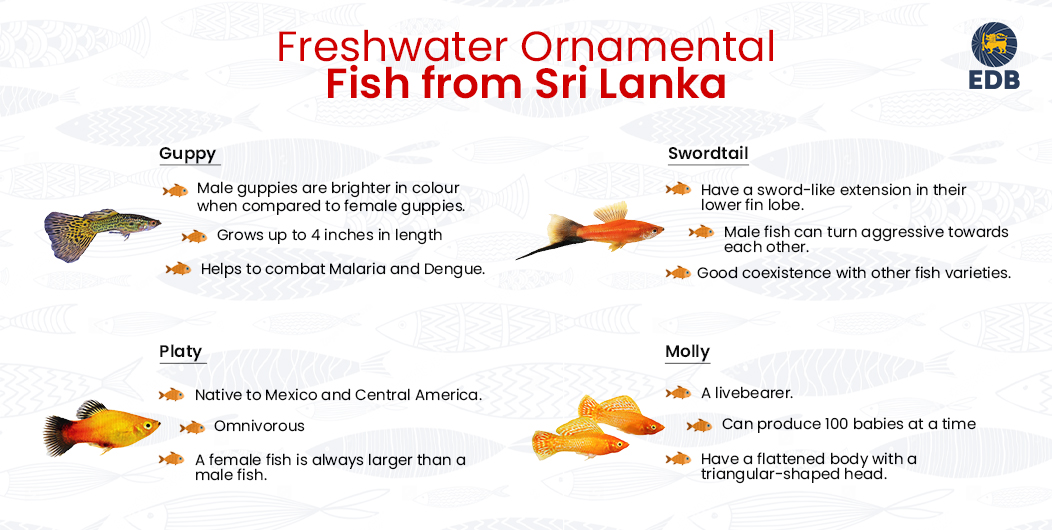
| Guppy | Swordtail | Platy | Molly |
With an insular ecosystem naturally designed to create ideal habitats for aquatic creatures, Sri Lanka is known to be the home of a highly demanded population of ornamental fish varieties. Approximately, more than 95 species of freshwater fish are present in Sri Lanka and 53 of them are endemic to the island’s water sources. Their biodiversity is influenced by the diverse freshwater river and stream system in the country.
The days of the Sri Lankan ornamental fish industry go back to the 1930s where several small-scale importers, breeders, and hobbyists carried out their practices. This was made official by 1952 when Sri Lanka’s first aquarium was built in the Dehiwala zoo. This soon turned out to become a commercialized industry that earned foreign income for the country. Germany, France, Japan, China, Poland, Italy, Canada, the United Kingdom, the United States and the Czech Republic are the major export markets served by the Sri Lankan ornamental fish industry.
Today, Sri Lanka exports a wide variety of ornamental fish species and Guppy, Swordtail, Platy, and Molly account for 60% of the export industry.
Scientifically known as Poecilia reticulata, Guppy aka the Million Fish is a widely distributed ornamental fish variety. They are hardy, energetic, easily kept, and prolific, the main reasons behind their popularity among hobbyists. They grow up to 4 inches in length and the male guppies have much brighter colours in comparison to their female counterparts.
While most fish reproduce through eggs, guppies just have their way. The eggs are incubated while they're still inside the female guppy; after being pregnant for a month, she gives birth to dozens of babies.
Guppies also play their part in saving the world. Their real fight is against malaria, an acute febrile illness that is sometimes fatal. Malaria is transmitted through mosquitoes and most Asian countries release guppies to water bodies so that they can live there feeding on the mosquito larvae.
The sword-like extension in their lower tail fin lobe has given this tropical fish variety its unique name. Swordtail is an elongated fish variety that grows to about 13cm. Even though swordtails are found in many coloured varieties, they were originally reported as green in colour with red stripes on each side.
Ornamental fish enthusiasts are spoilt for choice with many sub-breeds of Swordtail fish. Some of the most demanded breeds are Red, Black Calico, Ananas, Red Wag, Gold Cornet, and Gold Swordtail fish. Gold swordtails have a yellow-orange body with a red-tailed back with a lower margin. Contrary to what the name suggests, Red Wags are not red; they have orange bodies and black mouths. Black calicos sport a black body with a green-blue back and white fins.
It is a common misconception that Swordtails fight each other if they are kept together. This is not true. Male Swordtails are known to turn aggressive towards each other only during sexual maturity and this situation can be remedied by housing one male fish with several female fishes. When it comes to cohabiting with other varieties of fish, Swordtails are known to be excellent community fish that can coexist with other breeds such as platy, guppy, and molly.
Platy is one of the most well known ornamental fish breeds that belong to the Poeciliidae family. Native to Mexico and Central America, Platies are compact fish that grows about 2 inches long. Their colour variations are the result of being crossbred. Some of their popular varieties are Mickey mouse, Sunburst, Blue, Bumblebee, and Green Lantern Platies.
Platies live up to 3 - 4 years when kept in an optimal environment with clean water, low stress, and good nutrition. Like most fish, Platys are omnivores and accept all kinds of homemade and commercial fish food. They are peaceful, well-tempered fish that enjoy the company of other fish with a similar temperament. A slight chance of behaviour can be observed when a male chases a female when it is time to reproduce.
The female Platy chooses to be larger than the male. They are also fat around the abdomen. This makes it easier to differentiate between the male Platy and the female Platy. Since they tend to breed more often than most fish varieties, the male-female ratio in the aquarium is important.
Molly is a livebearer freshwater fish species similar to swordtail, platy, and guppy. It has a flattened body with a triangular-shaped head. Its body is wide at the midsection and tapers down to a narrow point at the snout. There are 39 subspecies of Molly Fish and some of the most well-known species are Black Mollies, Sailfin Mollies, Balloon Mollies, Lyretail Mollies, Dalmatian Mollies, and Gold Doubloon Mollies. When housed in aquariums, they seek more shelter from plants since they are inspired by the tropical waters they originally come from.
The largest species of Molly Fish can produce 100 babies at a time and they wish to have a clean tank when it comes to breeding. Most experts advise not to let the water temperature exceed 28 C. If they are caught up with a disease, they wiggle in one place, unable to swim properly. However, most of their health issues can be healed when the aquarium conditions are fixed.
Sri Lanka is one of the leading ornamental fish exporters to the world with our aquariums and fish farms successfully captive breeding some of the most exotic and rare freshwater, marine and brackish water fish species and marine ornamental invertebrates in the world